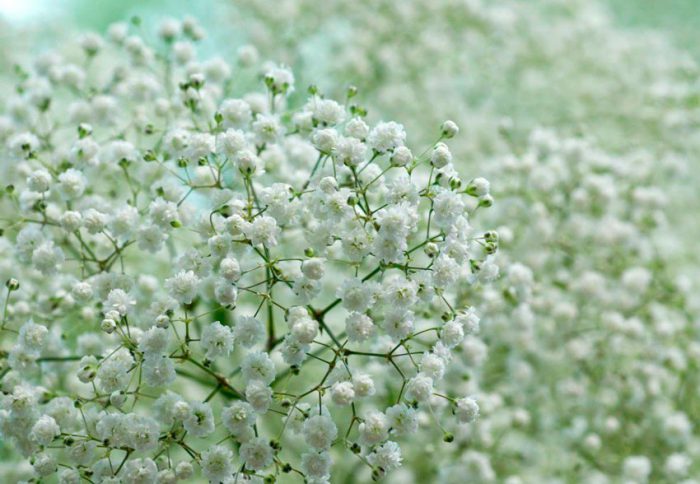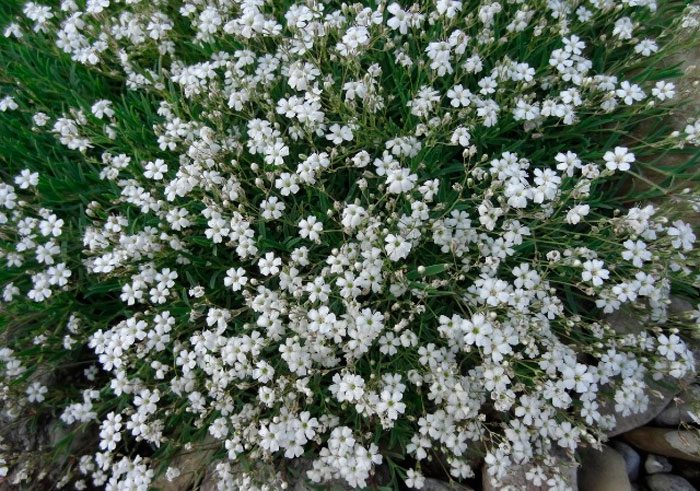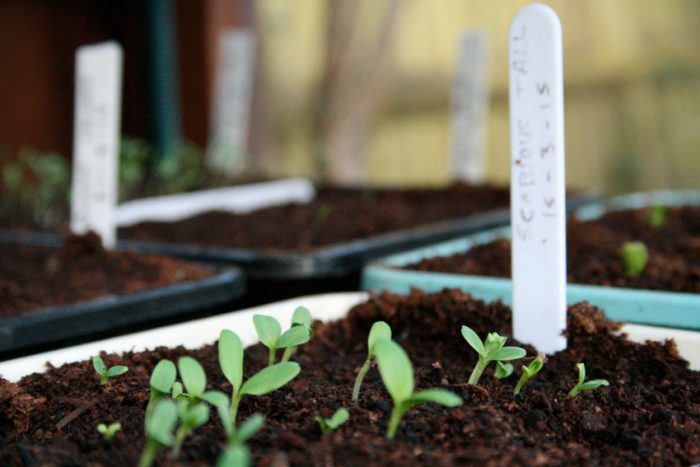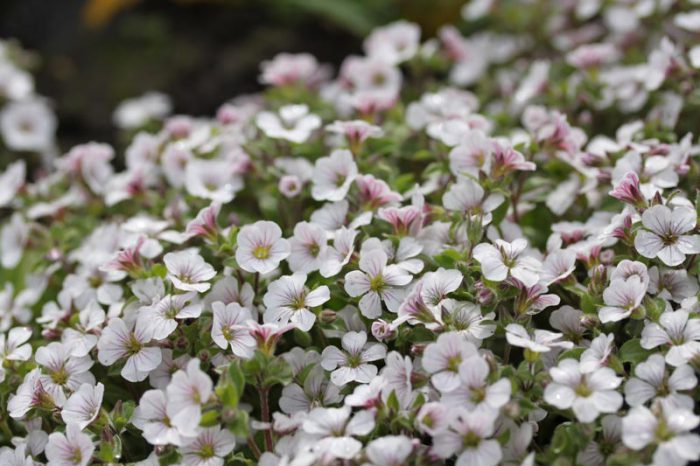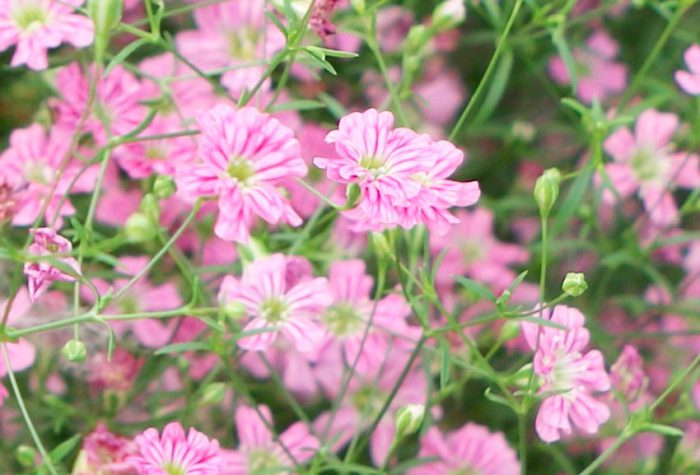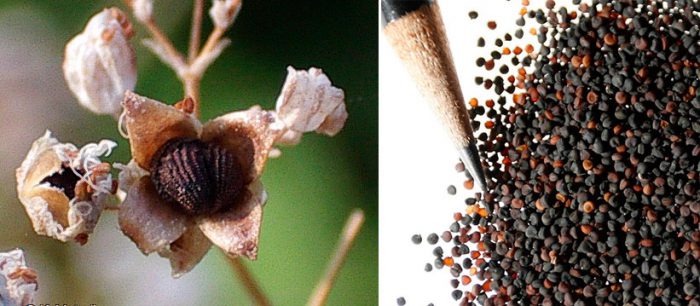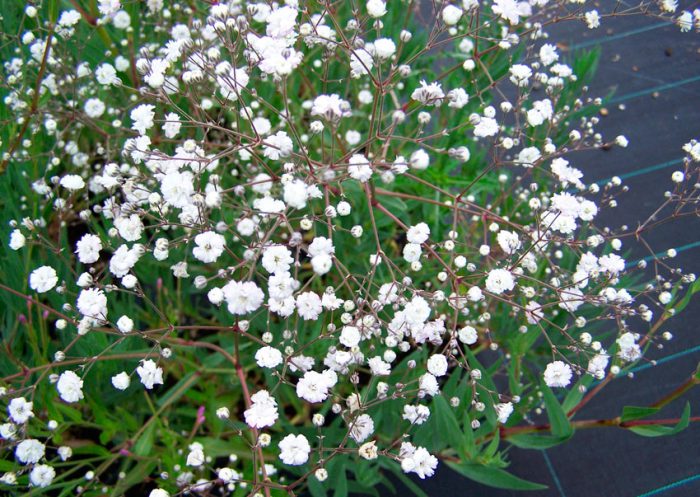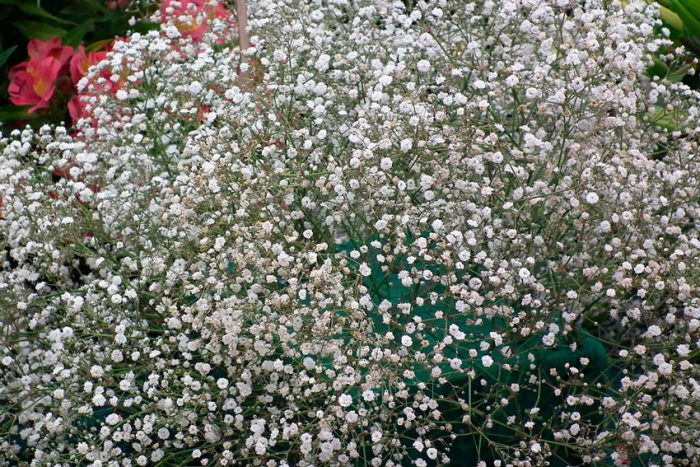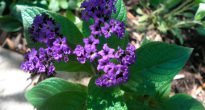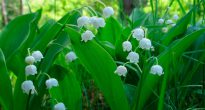Such a herb as gypsophila (Gypsophila) is also called kachim, tumbleweed, gypsophila. It is directly related to the carnation family. The name of this plant is translated as "loving lime", the fact is that most species of such a flower in natural conditions prefer to grow on limestone. This genus unites more than 100 species, such plants are represented by herbaceous perennials, annuals, and shrubs. Under natural conditions, it can be found in Northeast Africa, Eurasia and New Zealand. Gardeners cultivate both perennial gypsophila and annuals.
Content
Features of gypsophila
The strong taproot of this plant is branched. The erect or outstretched stem is practically leafless, its height varies from 20 to 50 centimeters. Semi-shrub species can grow up to 100 centimeters or more. Small, solid leaf plates are lanceolate, spatulate, or oval. Inflorescences are loose, paniculate. They include small greenish-white or white flowers, but in several species (for example, Pacific gypsophila or creeping) they have a pink color. They can be simple or terry. The fruit is a unilocular achene, the shape of which can be spherical or ovoid. These seeds remain viable for 2-3 years.
Growing gypsophila from seeds
Sowing
Gypsophila can be propagated both by seed and vegetative method. Such a plant, which is an annual, can only be propagated by seed; there are also perennials that propagate by seeds.
Annuals are sown before winter directly into open soil, while sowing is carried out on a training (spreading) bed. By the next spring period, the plants will get stronger, and they can be planted in a permanent place.
Perennials are grown through seedlings. To do this, at the beginning of spring, the seeds are sown in boxes, while they are distributed freely, and they are buried in the soil by only 5 mm. Cover the container with glass on top, and remove it in a warm place with good lighting.
Seedling
After 7-15 days, the first seedlings will appear. They need to be thinned out.So, the distance between plants should be about 15 centimeters. They can also be transplanted into individual peat pots. Further, the plants will need additional lighting, because the duration of daylight hours should be 13-14 hours.
Landing in open ground
What time to plant
After the flower has 1-2 true leaf plates, they should be planted in a permanent place. When choosing a suitable site, it is worth considering that perennial gypsophila can grow without transplanting for many years in a row. It is preferable for such a flower to choose a well-lit and dry place, while the soil should contain lime, as well as a little humus. If there is no lime in the soil, then it must be added there. For this you need 1 m2 take from 25 to 50 grams of CaCo3, while the pH of the soil should ultimately be in the range of 6.3–6.7. When choosing a site, remember that groundwater should not lie close to the soil surface, since gypsophila reacts negatively to dampness in the root system.
How to plant
When planting between flowers, a distance of 70 centimeters must be observed, and the aisles must be 130 centimeters long. When planting seedlings, remember that in no case should the root collar be buried in the ground. Planted flowers need to be watered. After a couple of years of planting, it will be necessary to thin out, since at this time by 1 m2 only 1 plant should grow. For those bushes that will be dug out, you need to cool the roots, and then they are planted in another place. This is to make the bushes look more spectacular during flowering. The cute flowers of such a plant are used for cutting, for example, they are often used to decorate composite bouquets.
The first flowering of such a plant can be seen after it grows at least 12 pairs of leaf plates. The most spectacular bush becomes 3 years after planting in a permanent place.
Care features
Even an inexperienced gardener can take care of such a flower. Watering should be done only during a dry and sultry period. During watering, water should be poured at the root. It is necessary to feed the plants 2 or 3 times during the whole season, while mineral fertilizers must be alternated with organic ones. It is recommended to take mullein infusion as an organic fertilizer, while fresh manure should not be used in any case.
Reproduction of gypsophila
In addition to seeds, this flower can be propagated by cuttings. For example, terry forms reproduce only by cuttings. Cuttings are recommended to be cut from young stems on which flowers have not yet begun to form, and this time falls just in May or the last days of April. Also, cutting of cuttings can be done in August by choosing young shoots for this. In order to root cuttings, they are planted in a loose substrate, which must include chalk. The stalk should be buried a couple of centimeters, and in order for it to take root well, the temperature should be maintained at about 20 degrees. Also, the cuttings of gypsophila need 12 hours of light, and they also need high air humidity (about 100%), so it is advisable to place the plant in a mini-greenhouse. To plant cuttings in the garden, you should choose a time so that they have time to get sick and take root before the onset of the autumn cold.
Diseases and pests
If the plant is improperly looked after, then it can get sick with rust or gray rot, and cyst-forming or root nematodes can also start in it. In order to destroy nematodes, you should use phosphamide, they need to spray the bush several times, while the breaks between treatments should be from 3 to 5 days. However, if the nematodes do not die, then you will need to dig out the bush and wash its root system in water, the temperature of which should be from 50 to 55 degrees. The fact is that nematodes die already at a temperature of 40 degrees.In order to get rid of gray rot and rust, it is necessary to use a contact fungicidal agent (oxychom, Bordeaux mixture, copper sulfate).
Perennial gypsophila after flowering
Seed collection
In the autumn, after the bush dries, in the place where the flowers were, small boxes appear in which small seeds are located, they are similar in size to brown grains of sand. The boxes need to be cut off. In the room, seeds are poured from them onto a piece of newspaper. They must be dried and ripened in a room with ventilation. Dried seeds need to be poured into paper bags or cardboard boxes, in which they will be stored.
Wintering
At the end of the autumn period, the perennial gypsophila must be cut off, while only 3 or 4 powerful shoots should remain at the root. Then the bushes must be covered with dried leaves or covered with spruce branches, this will save them during a winter with little snow or during severe frosts.
Types and varieties of gypsophila with photos and names
Gypsophila paniculata (Gypsophila paniculata)
This perennial plant can reach 1.2 m in height. The bush takes on a spherical shape in a fairly short time. On strongly branched shoots there are narrow greenish-gray leaf plates, on the surface of which there is pubescence. The flowers are small (about 0.6 centimeters in diameter), they are part of paniculate inflorescences. Depending on the variety, the flowers can be double or plain, white or pink. Varieties:
- Bristol Fairy. The bush reaches a height of 0.6–0.75 m, and there are white double flowers on it.
- Pink Star. Terry flowers, dark pink color.
- Flamingo. The bush reaches a height of 0.6-0.75 m. Terry flowers are pink.
Gypsophila graceful (Gypsophila elegans)
An annual plant, it has a spherical bush, it reaches a height of 0.4–0.5 m. Its shoots are highly branched, small lanceolate leaves and small flowers that can be painted pink, white or carmine. They are part of the openwork corymbose panicles. The bloom is lush, but does not last long. Varieties:
- The Rose. The flowers are pink.
- Carmine. The flowers are red.
- Double Star. This variety is undersized, the bush reaches a height of 15 to 20 centimeters. The flowers are deep pink.
Gypsophila creeping (Gypsophila muralis)
It is a branchy annual plant. The bush can reach a height of 0.3 m. Opposite dark green leaf plates have a linear shape. The panicles include small flowers of white or pink color. Varieties:
- Fratensis. The flowers are pink.
- Monstrose. The flowers are white.
Gypsophila Pacific (Gypsophila pacifica)
It is a perennial. The sprawling bush reaches 100 centimeters in height. Strongly branched shoots. Lanceolate wide leaf plates are colored bluish gray. The light pink flowers are about 0.7 cm in diameter.
Gypsophila jascolkovid, areciiform, tender and Patrena's gypsophila are also especially popular.

